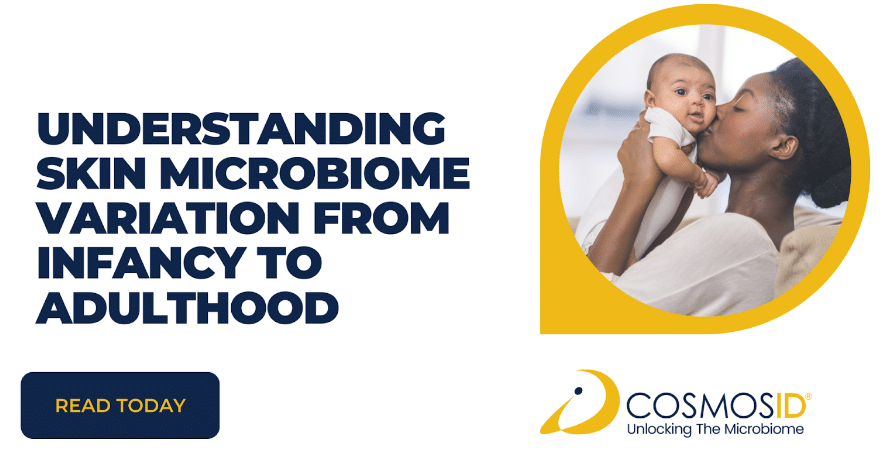Understanding the maturation of healthy skin during childhood has long been a subject of scientific interest. To address this knowledge gap, researchers conducted a comprehensive study in Germany, investigating skin parameters across various age groups.
The research team employed CosmosID for the skin microbiome sequencing, providing valuable insights into the maturation process.
Background
The study explored the skin microbiome composition on the dorsal forearm, comparing children to adults. The research group collected skin swab samples from 80 participants across four age groups: infants (0–2 years), young children (3–6 years), older children (7–<10 years), and adults (25–40 years) through repeated rubbing of swabs on a small confined skin area.
Then, the skin swabs are transferred to CosmosID. CosmosID played a crucial role in analyzing the skin microbiome. By targeting specific V1-V2 regions of the 16S ribosomal RNA gene, CosmosID allowed for detailed profiling of skin microbial communities.
Through analyzing the variation in the V1-V2 region sequencing, raw data was generated to provide valuable insights into the composition and diversity of the skin microbiome across age groups.
Then, physiological metrics as skin barrier function (SBF), skin hydration (SH), transepidermal water loss (TEWL), lipid compactness (LC), stratum corneum (SC) thickness, pigmentation and corneocyte size (CS) were measured.
Findings
The findings indicated that SBF, TEWL, LC, SC thickness, and CS continue to mature until around 6 years of age, reaching adult levels. TEWL and SH were consistently higher on the face compared to the arm.
Skin pigmentation increased with age, with higher melanin levels observed in older individuals.
Children exhibited a distinct microbiome composition, with Firmicutes dominating, while Proteobacteria dominated in adults. This highlights the evolving nature of the skin microbiome during childhood and emphasizes the importance of understanding microbial communities at different ages.
Staphylococcus and Streptococcus phyla from Firmicutes had higher abundance in babies than in other age cohorts. The relative abundance of the two Firmicutes phyla decreased with age.
Other genera such as Bacillus had relative abundance that positively correlated with children’s age, but disappeared in the adult cohort. but were almost totally absent in adults.
Shannon’s Index comparison of the age cohorts through ANOVA illustrated that the skin microbiome of infants, children and adults harbored similar levels of diversity.
The study’s findings provide important reference data for dermatological research and clinical practice. They contribute to our understanding of healthy skin development during childhood and set the stage for investigating diseased states.
Outcomes
Future research may focus on the interplay between the developing skin microbiome and immune system, as well as the influence of environmental factors and lifestyle choices on skin maturation.
This comprehensive study sheds light on the maturation of healthy skin during childhood. By utilizing microbiome sequencing techniques as done by CosmosID, researchers could uncover valuable insights into skin development, including changes in structure, function, composition, and the microbiome.
This knowledge serves as a foundation for further research and interventions in pediatric dermatology, aiming to maintain skin health and address dermatological conditions in children and adults.
How did CosmosID support this research?
By utilizing CosmosID’s state-of-the-art microbiome sequencing services, researchers were able to accurately detect and measure microbial composition of the skin. This enabled them to assess the development of healthy skin and provide important reference data for dermatological research and clinical practices.
The advanced analysis tools available on CosmosID’s platform also allowed researchers to generate meaningful information from their datasets, providing valuable insights into skin microbiome variation from infancy to adulthood. In addition, the platform provided researchers with an interactive visualization of the data, enabling simple and efficient interpretation.
Overall, CosmosID was instrumental in powering this research to a successful completion.
Looking to carry out your own microbiome research? Unlock the power of the microbiome today with CosmosID.
Want more like this? Sign-up to our newsletter to get the latest news from CosmosID:



